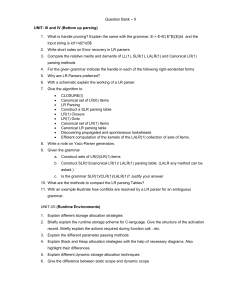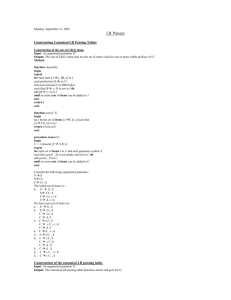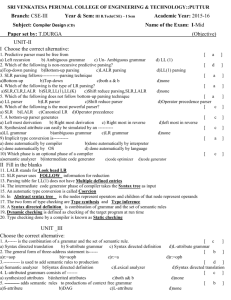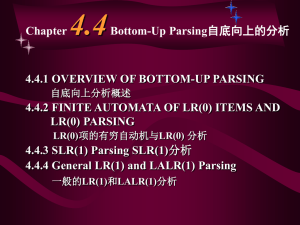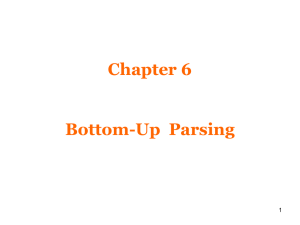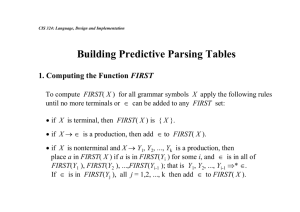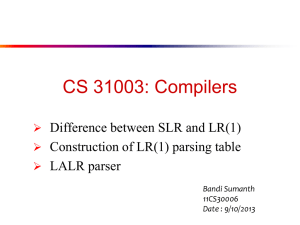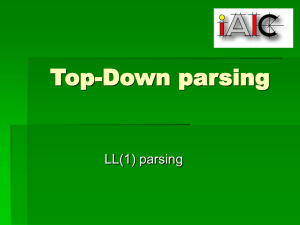Parser, LALR Parser
advertisement
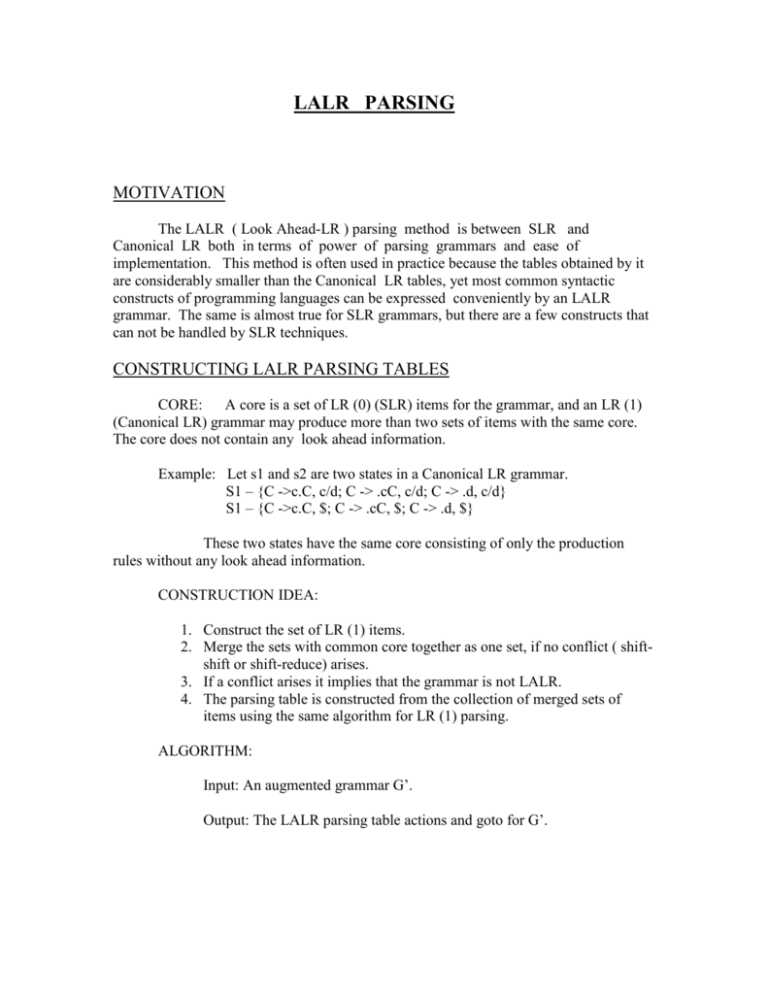
LALR PARSING
MOTIVATION
The LALR ( Look Ahead-LR ) parsing method is between SLR and
Canonical LR both in terms of power of parsing grammars and ease of
implementation. This method is often used in practice because the tables obtained by it
are considerably smaller than the Canonical LR tables, yet most common syntactic
constructs of programming languages can be expressed conveniently by an LALR
grammar. The same is almost true for SLR grammars, but there are a few constructs that
can not be handled by SLR techniques.
CONSTRUCTING LALR PARSING TABLES
CORE:
A core is a set of LR (0) (SLR) items for the grammar, and an LR (1)
(Canonical LR) grammar may produce more than two sets of items with the same core.
The core does not contain any look ahead information.
Example: Let s1 and s2 are two states in a Canonical LR grammar.
S1 – {C ->c.C, c/d; C -> .cC, c/d; C -> .d, c/d}
S1 – {C ->c.C, $; C -> .cC, $; C -> .d, $}
These two states have the same core consisting of only the production
rules without any look ahead information.
CONSTRUCTION IDEA:
1. Construct the set of LR (1) items.
2. Merge the sets with common core together as one set, if no conflict ( shiftshift or shift-reduce) arises.
3. If a conflict arises it implies that the grammar is not LALR.
4. The parsing table is constructed from the collection of merged sets of
items using the same algorithm for LR (1) parsing.
ALGORITHM:
Input: An augmented grammar G’.
Output: The LALR parsing table actions and goto for G’.
Method:
1. Construct C= {I0, I1, I2,… , In}, the collection of sets of LR(1)
items.
2. For each core present in among these sets, find all sets having the
core, and replace these sets by their union.
3. Parsing action table is constructed as for Canonical LR.
4. The goto table is constructed by taking the union of all sets of
items having the same core. If J is the union of one or more sets of
LR (1) items, that is, J=I1 U I2 U … U Ik, then the cores of
goto(I1,X), goto(I2,X),…, goto(Ik, X) are the same as all of them
have same core. Let K be the union of all sets of items having
same core as goto(I1, X). Then goto(J,X)=K.
EXAMPLE
GRAMMAR:
1.
2.
3.
4.
S’ -> S
S -> CC
C -> cC
C -> d
I0 : S’ -> .S, $
S -> .CC, $
C -> .c C, c /d
C -> .d, c /d
I1: S’ -> S., $
I2: S -> C.C, $
C -> .Cc, $
C -> .d, $
I3: C -> c. C, c /d
C -> .Cc, c /d
C -> .d, c /d
I4: C -> d., c /d
I5: S -> CC., $
I6: C -> c.C, $
C -> .cC, $
C -> .d, $
I7: C -> d., $
I8: C -> cC., c /d
I9: C -> cC., $
STATES:
CANONICAL PARSING TABLE:
STATE
0
Actions
c
d
S3
S4
Goto
$
1
S
C
1
2
acc
2
S6
S7
5
3
S3
S4
8
4
R3
R3
5
6
R1
S6
S7
7
8
9
R3
R2
R2
9
R2
NOTE: For goto graph see the construction used in Canonical LR.
LALR PARSING TABLE:
goto
START
0
Actions
C
S36
D
S47
1
$
S
1
C
2
Acc
2
S36
S47
5
36
S36
S47
89
47
R3
R3
5
89
R3
R1
R2
R2
R2
I0
I1
I2
I5
I6
I8
I3
I9
I4
I7
Showing states with same core with same colour which get merged in conversion
from LR(1) to LALR.
States merged together: 3 and 6
4 and 7
8 and 9
SHIFT-REDUCE CONFLICT
COMPARISON OF LR (1) AND LALR:
If LR (1) has shift-reduce conflict then LALR will also have it.
If LR (1) does not have shift-reduce conflict LALR will also not have it.
Any shift-reduce conflict which can be removed by LR (1) can also be removed
by LALR.
For cases where there are no common cores SLR and LALR produce same
parsing tables.
COMPARISON OF SLR AND LALR:
If SLR has shift-reduce conflict then LALR may or may not remove it.
SLR and LALR tables for a grammar always have same number of states.
Hence, LALR parsing is the most suitable for parsing general programming
languages.The table size is quite small as compared to LR (1) , and by carefully
designing the grammar it can be made free of conflicts. For example, in a language like
Pascal LALR table will have few hundred states, but a Canonical LR will have thousands
of states. So it is more convenient to use an LALR parsing.
Lectrure 1: Kumar Deepak 03CS1036 dt: 13.09.05
Lectrure 2: Joy Deep Nath 03CS3021 dt:13.09.05
REDUCE-REDUCE CONFLICT
However, the Reduce-Reduce conflicts still might just remain .This claim may be better
comprehended if we take the example of the following grammar:
S’-> S
S-> aAd
S-> bBd
S-> aBe
S-> bAe
A-> c
B-> c
Generating the LR
(1) items for the above grammar,
I0 : S’-> .S , $
S-> . aAd, $
S-> . bBd, $
S-> . aBe, $
S-> . bAe, $
I1: S’-> S ., $
I2: S-> a . Ad, $
S-> a . Be, $
A-> .c, d
B->.c, e
I3: S-> b . Bd, $
S-> b . Ae, $
A->.c, e
B->.c,d
I4: S->aA.d, $
I5: S-> aB.e,$
I6: A->c. , d
B->c. , e
I7: S->bB.d, $
I8: S->bA.e, $
I9: B->c. , d
A->c. , e
I10: S->aAd. , $
I11: S->aBe., $
I12: S->bBd., $
I13: S->aBe., $
The underlined items are of our interest. We see that when we make the Parsing table for
LR (1), we will get something like this…
The LR (1) Parsing Table. (partly filled)
a ………………
I1
I2
.
.
.
I6
..
.
.
I9
d
.
.
.
.
e
.
.
.
.
……………….
r6
.
.
.
.
…………………. r7
r7
.
.
.
.
r6
.
This table on reduction to the LALR parsing table, comes up in the forms of-
The LALR Parsing table. ( partly filled)
a ………………
I1
I2
.
.
.
I69
..
.
.
I9
.
d
.
.
.
.
……………….
r6/r7
.
.
.
.
…………………. r7
e
.
.
.
.
r7/r6
.
.
.
.
r6
So, we find that the LALR gains reduce-reduce conflict whereas the corresponding LR (1)
counterpart was void of it. This is a proof enough that LALR is less potent than LR (1).
But, since we have already proved that the LALR is void of shift-reduce conflicts (given that
the corresponding LR(1) is devoid of the same), whereas SLR (or LR (0)) is not necessarily
void of shift-reduce conflict, the LALR grammar is more potent than the SLR grammar.
SHIFT-REDUCE CONFLICT present in SLR
Some of them are solved in….
LR (1)
All those solved are preserved in…
LALR
So, we have answered all the queries on LALR that we raised intuitively.
